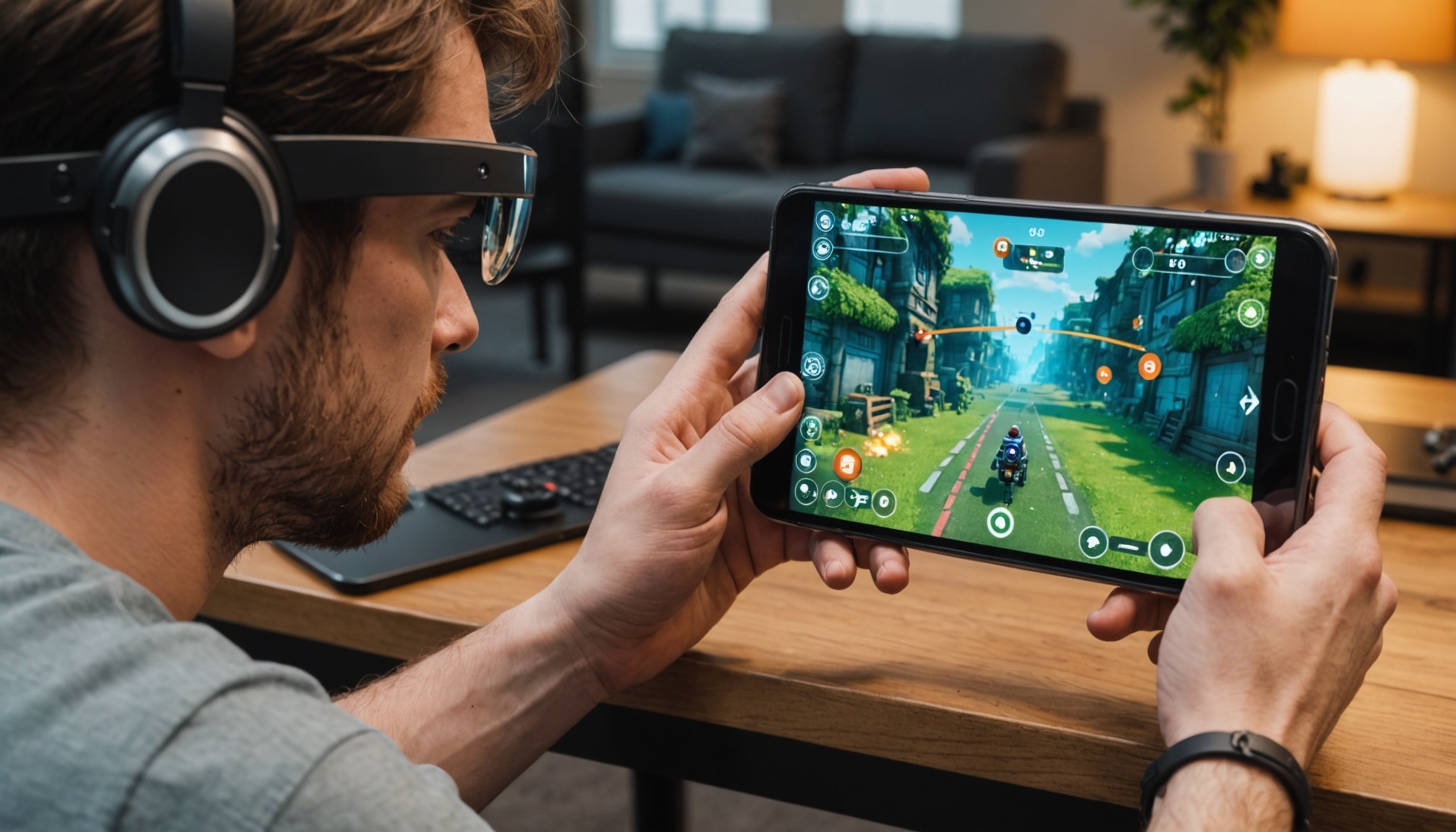Introduction to Haptic Feedback in Mobile AR Games
In the world of Mobile AR Games, Haptic Feedback plays a crucial role in enhancing the user experience. This technology offers tactile sensations, enriching the virtual interactions with a layer of physical realism. Incorporating haptic feedback can elevate the gaming experience by providing motion and vibration responses that mimic real-world physical effects. The sensation of touch and movement, when integrated effectively, creates more engaging and immersive environments.
The importance of user experience cannot be understated in the gaming industry. Players seek immersive and entertaining experiences, where haptic feedback becomes a key component. By simulating a sense of touch, game developers can make experiences more authentic and dynamic, contributing positively to the player’s overall satisfaction.
Also read : Essential Elements for Crafting Authentic Cloudscapes in Flight Simulation Games
However, integrating haptic feedback in AR presents challenges. This involves ensuring smooth interaction between software elements and hardware capabilities, as developers face hurdles like device compatibility, maintaining seamless user experience across different platforms, and overcoming limitations in existing haptic technologies. The journey to incorporate these technologies effectively requires addressing these technical challenges and ensuring the result is both feasible and satisfying for the end-user.
Technical Challenges of Integrating Haptic Feedback
Implementing haptic technology in Mobile AR Games involves significant technical challenges. Compatibility issues with existing mobile devices are at the forefront. Not all devices are equipped to support advanced haptic feedback, leading to inconsistent experiences across users’ hardware. This inconsistency can disrupt the overall user experience, which is crucial in gaming.
Also to read : Mastering Input Lag: Top Techniques to Enhance Competitive Console Gaming Performance
Current haptic technology also struggles to fully accommodate the needs of AR environments. The limitations in replicating comprehensive touch sensations can hinder immersion. This is further complicated by the challenge of synchronising haptic feedback with visual elements. Achieving seamless integration requires precise coordination between touch and sight to avoid any sensory dissonance, which could break the illusion of realism.
Additionally, developers face hurdles in adapting haptic responses for varied gameplay mechanics. Each game element may require custom tactile feedback, demanding sophisticated design strategies. These integration issues form a complex landscape that developers must navigate to deliver satisfying and immersive experiences. By prioritising solutions to these challenges, the future of haptic feedback in Mobile AR Games looks promising.
Design Considerations for Effective Haptic Feedback
Incorporating haptic feedback effectively requires careful consideration of user interface design. Prioritising how such feedback interacts with gameplay mechanics is crucial to maintaining immersion. The key lies in designing feedback that enhances rather than overwhelms. Overloading users with complex haptic signals can detract from the experience if not balanced correctly.
Best practices suggest a minimalist approach, where feedback accentuates key moments without becoming intrusive. Developers should ensure haptic responses align with game actions, synchronising touch with relevant visual cues to support user engagement. The goal is to create an intuitive, responsive experience that supplements visual elements, fostering a cohesive interaction.
In terms of haptic design, understanding the game’s narrative and thematic elements allows for tailored haptic patterns that resonate with the story. This enhances emotional impact, making player interactions feel more meaningful. Thoughtfully designed interfaces integrate haptic cues with ambient game soundscapes, thereby enriching the overall atmosphere. These design considerations are vital for harnessing the full potential of haptic technology in mobile AR games, ensuring it adds value rather than complexity to the user’s journey.
Case Studies of Haptic Feedback Implementations
Exploring case studies in haptic integration offers valuable perspectives on its application in mobile gaming. A notable example is the game “Pokémon GO,” which uses haptic feedback to alert players to nearby Pokémon, enhancing the user experience by providing real-time immersion. By integrating tactile responses, players are more engaged as they explore virtual worlds overlaid on real environments.
In reviewing such games, user feedback highlights increased enjoyment and attentiveness, especially when haptic technology is well-synchronised with visual and auditory elements. Performance metrics from these implementations indicate that well-calibrated haptic prompts can minimise distractions, maintaining an immersive experience without overwhelming users.
However, there are lessons from less successful implementations too. Games that failed often did so due to poor haptic integration, which led to sensory dissonance. These experiences underscore the importance of precise synchronisation between haptic cues and other sensory elements. Developers can glean insights from both triumphs and shortcomings to refine the use of haptic feedback, ensuring that it enhances rather than detracts from the user experience.
Innovative Solutions and Future Directions
In the evolving landscape of haptic technology, innovative solutions continually emerge, promising to redefine user experience in Mobile AR Games. Pioneering developments are focusing on advanced actuators capable of delivering more nuanced tactile sensations. These actuators aim to replicate complex touch experiences, enriching the gaming environment further. Emerging technologies such as ultra-thin haptic displays are also being explored, offering exciting possibilities for richer, more immersive interactions.
Future trends in AR gaming predict a surge in popularity as these innovations become more accessible and cost-effective. Improved haptic technology is set to play a critical role in retaining player engagement and enhancing realism. As devices become increasingly sophisticated, opportunities for deeper, more engaging user experiences will expand.
Experts anticipate that continuous improvements and refinements in haptic feedback will be essential for maintaining competitive edge in mobile gaming. This includes leveraging AI to personalise haptic responses based on player behaviour and preferences. As a result, game developers are encouraged to stay informed of technological advances to integrate these innovative solutions seamlessly, ensuring a balance between cutting-edge features and user-centric design. These developments herald a promising future for AR games, emphasising immersive engagement through tactile interactions.
Insights from Industry Experts
Understanding the pulse of haptic feedback in Mobile AR Games is crucial for advancement. Interviews with industry leaders reveal valuable expert opinions shaping these strategies. One key insight is the emphasis on user experience; experts suggest prioritising end-user needs to drive innovation.
Industry insights underline the importance of haptic feedback strategies that incorporate user-centric design. Experts recommend balancing realism with subtle enhancements to complement game narratives. This ensures that haptic cues become a seamless part of storytelling, engaging players without overwhelming them.
Moreover, leading voices in the industry stress the significance of rigorous user testing. Continuous feedback loops are vital for refining and enhancing haptic experiences, allowing developers to tailor responses effectively. User-testing helps identify what resonates with audiences, fostering improvements that are both immersive and intuitive.
Expert recommendations further highlight collaborative approaches. By working closely with hardware and software teams, developers can overcome integration challenges, aligning visions for cohesive gameplay experiences. These collective efforts ensure the full realisation of haptic technology’s potential, setting a benchmark for future innovations in mobile gaming.
Summary of Best Practices for Developers
Incorporating haptic feedback into Mobile AR Games presents unique challenges and opportunities. Successful integration begins with adhering to best practices that ensure a seamless user experience. It’s crucial for developers to prioritise user testing early in the design phase. This allows for iterative improvements based on real player interactions.
Developer guidelines emphasize the importance of synchronising haptic cues with visual and auditory elements. Aligning these sensory components can prevent sensory overload and enhance immersive experiences. Additionally, developers should focus on creating context-sensitive feedback. This means haptic responses should be relevant and intuitive, augmenting rather than distracting from the gameplay.
Another valuable approach is ongoing user engagement. Regularly gathering feedback post-launch helps in refining and updating haptic features. This adaptive process ensures the game remains engaging and evolves with user needs. Moreover, collaboration with hardware developers facilitates overcoming technical hurdles, contributing to more refined solutions.
Ultimately, balancing technological innovation with user-centric design is key. By remaining flexible and attentive to player feedback, developers can craft compelling, immersive Mobile AR experiences that leverage the full potential of haptic technology.











